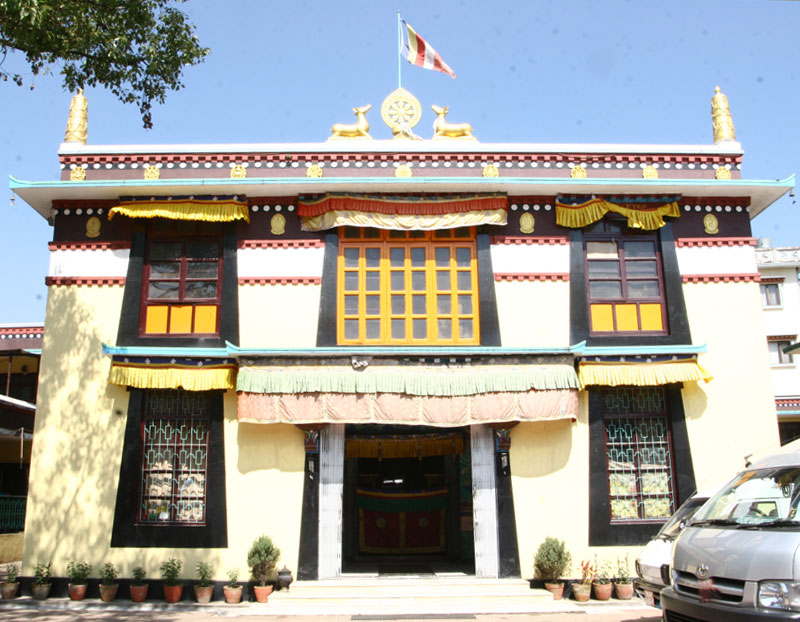
Phelgyeling Monastery now in Kathmandu, Nepal, was originally located in Nyanang, Tibet, not far from the Nepali border. It has a statue of Dharmapala Dorje Shugden made by the Fifth Dalai Lama himself, who converted the monastery from Kagyu to Gelugpa in 1665.
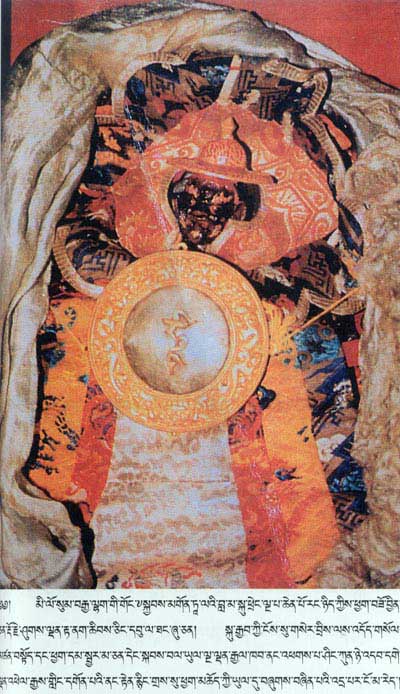
This Dorje Shugden statue, currently at Gaden Pelgyeling Monastery, Nepal, was offered by His Holiness the Great 5th Dalai Lama to the Monastery centuries ago.
It was in the original monastery in Tibet, but during the escape of the monks to Nepal in 1959, it was one of the treasured items taken out. When Pelgyeling was re-established in Nepal, this holy statue was re-installed in the protector chapel. It draws many pilgrims who have their wishes fulfilled upon prayer to this sacred image.
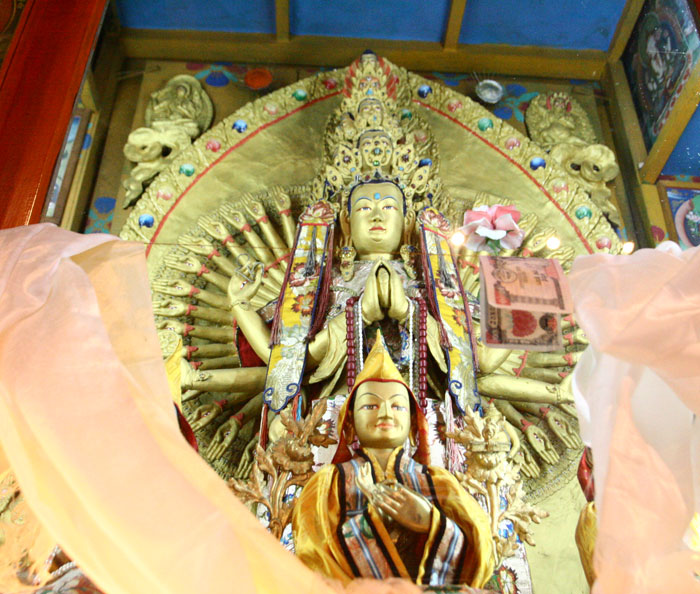

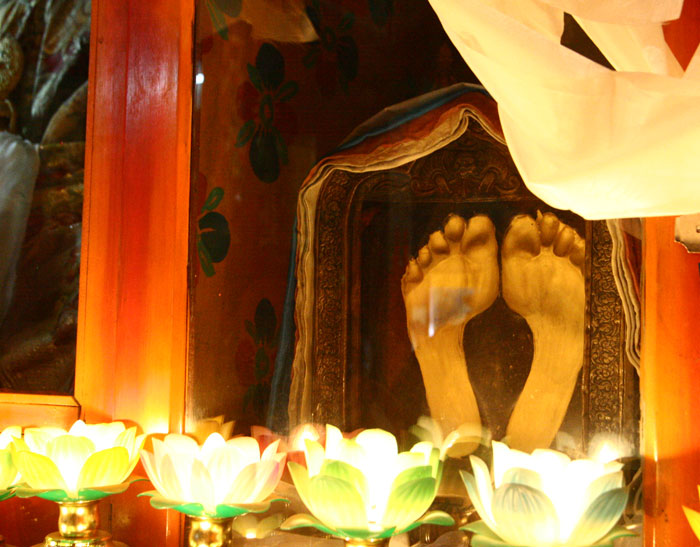
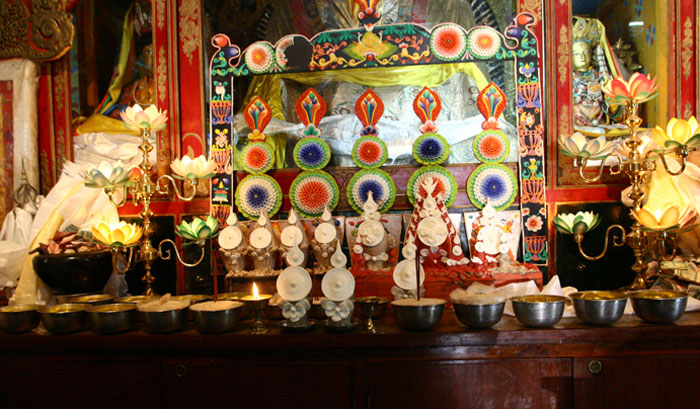
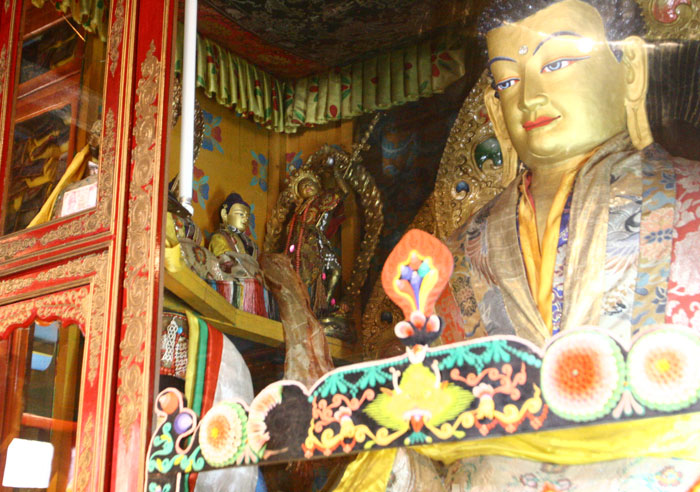
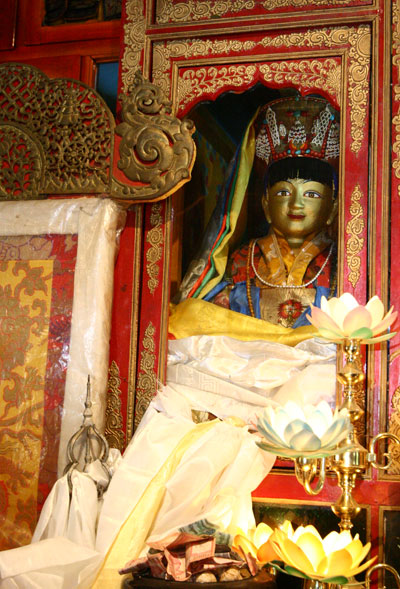
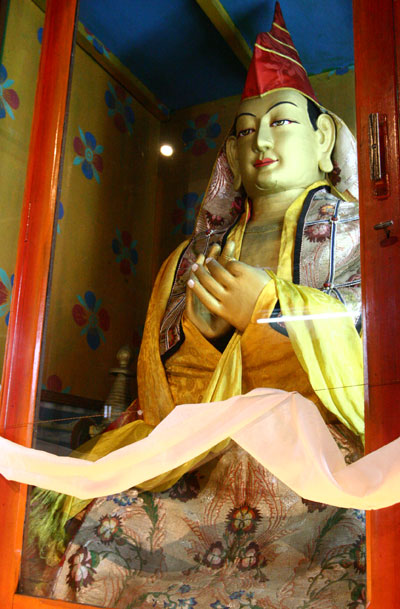
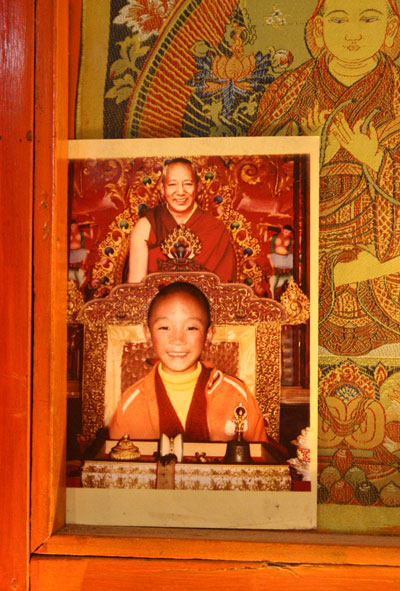
Photo of the previous and current Kyabje Zemey Rinpoche
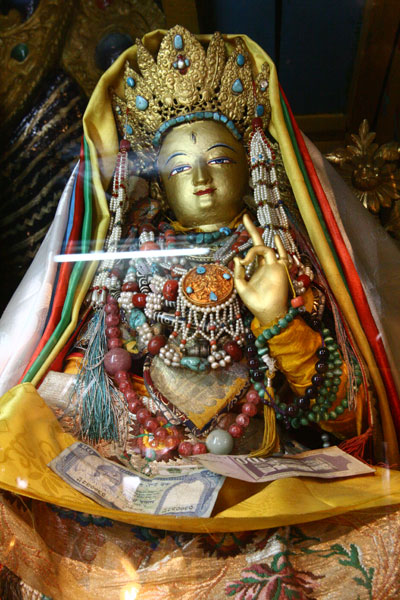
The famous Tara statue that spoke
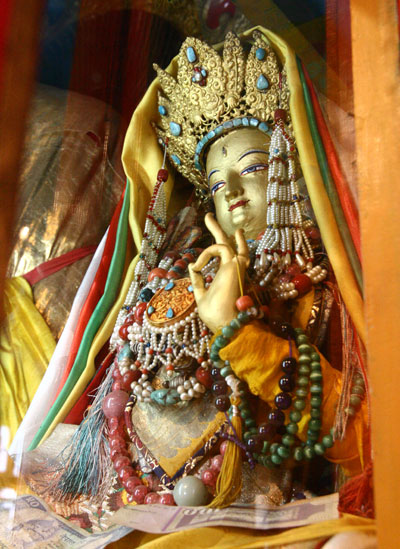
The famous Tara statue that spoke

Ursula Bernis, PhD, interviewed a great number of Tibetans in the year 1997. Among them were the monks of Phelgyeling Monastery, whose predecessors received the transmission of the Wisdom Buddha Protector Deity Dorje Shugden from the Fifth Dalai Lama, along with a statue for them to venerate it.
As you will see, these monks were harassed quite cruelly already in 1996/97.
Two days ago the Society alerted us that Rinchen Dharlo, an official for the Dalai Lama that lives in New York, is travelling all the way from America to Nepal to meet there with a minister of the Tibetan government in exile.
The objective of this encounter is to round up the people from Nyanang, organize them and send them against the Phelgyeling monks, to force them to once and for all give up the practice of the Protector, that they have been doing for centuries.
This is a direct attack on their human rights on one hand, and a meticulously planned heavy wrong action against the Sangha. This sacrilege is being committed by the Dalai Lama while he preaches to the world that one should respect and tolerate other people’s religion. The world showers upon him praise ignoring his unlawful actions. No doubt this world is the external abode of samsaric mind, its projection.
What can we do beyond changing our own minds internally to influence that samsaric mandala?
In this particular case and other specific ones we should write to the local authorities, particularly the local police, to physically protect the monks.
Otherwise, the only thing we can do is to go on alerting the world about the Dalai Lama’s actions, time and again, time and again, until a significant number of independent thinking characters with a voice in the media understand.
From Ursula Bernis’ book
Phelgyeling Monastery now in Kathmandu, Nepal, was originally located in Nyanang, Tibet, not far from the Nepali border. It has a statue of Dharmapala Dorje Shugden made by the Fifth Dalai Lama himself, who converted the monastery from Kagyu to Gelugpa in 1665.
The monks showed it to me. It is a revered treasure object, about twelve to sixteen inches high with only the face visible since, like many Buddhist statues, it is covered in brocade and kept in a glass covered container high up on a shelf. A young, English-speaking monk showed me around the small monastery, and the older monks he introduced me to contributed to the following history of the monastery. Kathmandu, November 10-12, 1997:
Since Nyanang was so close to the border, we were able to save many of our holy objects across the border to Nepal. At first sixteen monks had escaped from Tibet. They were dispersed in Kathmandu valley and we could not meet regularly at first.
In 1970, we finally gathered enough support and with the help of Tsenshab Serkong Rinpoche we were able to establish Phelgyeling at the foot of the Swayambhu mount. The area has been one of the most holy places in the Himalayas since ancient times and is believed to belong to Manjushri. On top is a huge stupa and on one side is the entrance to the underground lake where the nagas live and from where Manjushri brought the Prajna Paramita sutras.
Phelgyeling had a hundred seventy monks before 1959 in Tibet. Now, out of eighty monks about twenty-five are children. We try to bring them up in the Buddhist way since we Tibetans are trying to preserve our heritage. There are plenty of schools in Kathmandu from which parents can choose to educate their children. Many want their children to grow up in the traditions of knowledge we have cherished in Tibet for hundreds of years.
Geshe Thardö, the abbot of Phelgyeling: I have been a monk for fifty years and came to Phelgyeling when I was seven years old. Serkong Tsenshab Rinpoche was my Guru whom I served for several years. Serkong Tsenshab Rinpoche established the monthly schedule of rituals and prayers for the monastery. [He shows me the schedule and explains,] the first day of the month we perform the rituals of the Sixteen Arhats, the second day Dorje Shugden and Palden Lhamo, and so on.
In 1966, Serkong Rinpoche advised us to perform Dorje Shugden’s monthly fulfillment ritual (Tib. bskang.gso). Before that, we were only doing the ritual of requesting activities. Serkong Tsenshab Rinpoche came to the monastery for the last time in 1978. At the time he was a religious counsel (Tsenshab) to His Holiness and had taken up the anti-Dorje Shugden “advice.” The young incarnation visited Phelgyeling twice, once before the more intense 1996 ban and once after.
He says that before the ban many people came to pray at the very special Dorje Shugden statue constructed by the Fifth Dalai Lama himself. The monastery today still uses the four exhortation verses (Tib. ‘phrin.bskul) composed by the Fifth Dalai Lama to Dorje Shugden and the rituals composed by Kyabje Pabongka Rinpoche.
In early 1996, Dharamsala informed its government representatives, the Women’s Association, and the Tibetan Youth Congress to tell people not to go to Phelgyeling Monastery anymore because they rely on Dorje Shugden and are against the Dalai Lama.
In May 1996 seven representatives of those organizations came to the monastery and asked to talk to the older monks. About six or seven older monks met with them in the kitchen. The representatives said that if the monastery continued to rely on Dorje Shugden, there would be problems with Tibetan politics and no freedom for Tibet. They also said that the Dalai Lama would die if Phelgyeling continued the practice.
Q: What was the exact exchange of words?
A: The representatives asked whether we relied on Dorje Shugden. The monks said yes, we did, but not just since we came out of Tibet. We have relied on him since the time of the Fifth Dalai Lama when the monastery was established.
The representatives told the monks that relying on Dorje Shugden is against our freedom and harmful for the Dalai Lama’s life. They told us to listen to the Dalai Lama. He said he had checked many times and found it is bad for Tibetan freedom.
The monks asked in return, if we stopped Dorje Shugden practice, when would we get freedom? If we got freedom, we would stop the practice but we would like to know when. The monks said there is no reason why Dorje Shugden practice would be bad for freedom. Dorje Shugden promised to help the Tibetan government; this is written in the fulfillment ritual. And it could not harm the Dalai Lama’s life, since he is Avalokiteshvara. Dorje Shugden is a protector of Buddhism, there is no way he can possibly harm.
One Geshe told the representatives that he wanted to sign something that says if we continue to practice Dorje Shugden, this is not bad for the Dalai Lama. He said, we did so many long-life rituals and prayers for the Dalai Lama and he promised to stay until he is at least eighty years old, so there is no need to worry about the Dalai Lama’s life being affected by our religious practice.
Some of the representatives in the group said that Dorje Shugden destroys the [fulfillment of the] Dalai Lama’s wishes. Not all within the group agreed. The monks told them that the Thirteenth Dalai Lama, Thubten Gyatso, gave many predictions concerning the future of Tibet. He knew exactly when he would pass away and wrote it down. He does not mention anywhere [in his autobiography, for example] that there would be any harm coming from Dorje Shugden in the future or anything at all negative about this protector.
In the Shakabpa text, it is mentioned that the Thirteenth Dalai Lama is a disciple of the previous Tomo Geshe Rinpoche. His Dorje Shugden oracle recommended to renovate the Potala and Ganden stupa. He said this would be good for the Dalai Lama’s life’s work.
The representative of the Tibetan government asked if there was a Dorje Shugden statue in the monastery. The monks told him, “Yes, but it was made by the Fifth Dalai Lama and is a precious holy object (Tib. phyag mtshan) for the monastery.” They asked, “Are you practicing Dorje Shugden? And will all these young monks practice it or will they listen to what the Dalai Lama says?” They told us that the Dalai Lama had said that old monks are like old trees, they don’t easily bend, but the young ones should change.
The monks answered that the old ones do the practice and the young ones follow. That is the way a monastery functions, the young ones don’t run it. “If you want to ask them whether or not they will sign the statement promising to give up Dorje Shugden, go right ahead. We have to follow the Gurus, texts, and rituals which we have done from Tibet till now.
This is also the wish of His Holiness for each individual to follow his Guru and that each lineage has to study their own texts and preserve its practices. Phelgyeling follows the Fifth Dalai Lama, the texts and studies which we have done until now. This is the Dalai Lama’s wish.”
[The abbot continues:] Thirteen different societies or organizations came to the monastery and I wrote down exactly when they came, how many came, and what they said. They all said, you must stop Dorje Shugden. Many asked if we had any connection to Geshe Kelsang Gyatso. They came and told us we were listed as a member of the SSC (Shugden Supporters Community). If you do not belong to them, write a letter to the government saying so, they demanded.
Since Geshe Kelsang Gyatso is a disciple of Kyabje Trijang Rinpoche, we have a spiritual connection. We know he relies on Dorje Shugden. We respect him but we don’t have any direct connection with him or get any money from his organization. Dharamsala sent several letters asking us to denounce Geshela, but we did not.
Even the people from Nyanang, the place we are from originally and our main supporters, came and told us to stop practicing. They asked us to write a letter stating that we no longer practice Dorje Shugden. They said, if you don’t, we will not come to the monastery anymore, support you, or have any connection with you.
Every year the people from Nyanang request the monastery to read the whole canon of the Buddha’s words (Kangyur). This is a big event and also brings financial support for the monastery. After the ban, they stopped.
The committee members in charge of organizing the yearly reading came and demanded from Phelgyeling again that we stop the practice of Dorje Shugden. They said it is the Dalai Lama’s advice. If you stop, we will have the Kangyur read again and will continue our relationship with you.
We told them that we had listened to the Dalai Lama’s speech and follow his advice. His Holiness is our Guru because we got initiations from him. He who gave us the initiation of Dorje Shugden is also our Guru. Therefore, we cannot stop. We already told all the organizations that came to persuade us, we cannot stop. We know that a religious action has to be done out of one’s own will; it cannot be forced by anyone else.
The committee of the Nyanang organization offered the money they usually spend on having the Kangyur read at Phelgyeling during the time when the Nepalis kill so many animals as sacrifice [Durga Puja] to a Nyingma monastery in the mountains. Every year the Tibetan government sponsors—that is, pays for—rituals in every monastery.
This year (1997) the Tibetan government stopped offering rituals at Phelgyeling. Once a year the government makes offerings of a hundred thousand tsog (collection) at Dilgo Khyentse Rinpoche’s monastery. This year they announced, whoever practices Dorje Shugden cannot attend the rituals.
Five or six months ago the Tibetan government sent a letter saying that we have to make rituals (Tib. zhabs brtan) for the Dalai Lama. We do Yon tan bod skyong lha gsum ‘phrin bskul every day, we answered. It is not true that we do not follow the Dalai Lama’s advice and wishes. Whenever we have asked the Dorje Shugden oracle, he says to do these rituals and pray for the long life of the Dalai Lama. We always do this.
Q: How do you see the future of the monastery?
A: The Dorje Shugden problem already started at the time of the Fifth Dalai Lama. But then he practiced it and built monasteries for Dorje Shugden. I think it will become like this. In any case, I don’t believe it will get worse.
Q: Why do you practice Dorje Shugden?
A: Very high Gelugpa Lamas practiced this. He is really a reliable protector. Serkong Dorje Chang, Pabongka Rinpoche, Dzemey Rinpoche, Kyabje Trijang Rinpoche practiced it. They did not think there was a problem with it.
If people don’t believe this, they have to get rid of all the texts by Pabongka and Trijang Rinpoches and stop the whole lineage. We cannot understand the Dalai Lama’s wish. Perhaps it is similar to the injunction in the Buddhist sutras against meat and alcohol, while in Vajrayana, you can use them. Buddha said do and don’t, both.
Q: Why did His Holiness advise against Dorje Shugden practice at this particular time?
A: He gave Tamdin Yangsang initiation. If you practice Dorje Shugden, he said, don’t come. There were many people who rely on Dorje Shugden present at the initiation. We have to know the relation between these two—Tamdin Sangdrub is a Gelugpa mediational deity and Tamdin Yangsang is not Gelugpa, it is Nyingma. It is better not to mix them.
If you rely on Dorje Shugden it would be better to receive the Gelugpa Tamdin, rather than the Nyingma as His Holiness was bestowing at the time. It is not that Dorje Shugden wants to harm Nyingmas, as some people have ignorantly said, they simply have different functions. It is the same religion but like making different dishes, they are separate.
In Nyanang, the Kagyu and Nyingma monasteries practiced Dorje Shugden and Phelgyeling, our monastery, which is Gelugpa, performed the ritual dance (Tib. ‘chams) of Dorje Trollo, mostly a Nyingma practice. Here in Nepal, Guru Tsengye, from that Nyingma monastery in Nyanang, still relies on Dorje Shugden and I know of a Nyingma Lama in Changmang who relies on all the Gelugpa protectors.
If we wanted initiations from the Dalai Lama and money from the government we would also stop. But we don’t. We have this very precious lineage that comes to us from the Fifth Dalai Lama.








































 English
English Indonesia
Indonesia Tibetan
Tibetan
Sarah
September 21, 2010
The Pelyeling Monastery is very special because of its lineage that comes directly from the Fifth Dalai Lama. It still preserves the statue made by the Great Fifth which dates from the 17th century. The monastery has many beautiful statues and even a Tara statue that spoke! The two famous statues must be the monastery’s main attractions! I like this video because it is accompanied by a write-up on the history, its relocation from Tibet and its present problems due to the ban on the Dorje Shugden practice. It is interesting to note that in Nyanang, the Kagyu and Nyingma monasteries also practised Dorje Shugden.
arisa
January 8, 2011
Phelgyeling Monastery was a Kagyu Monastery located in Tibet near the Nepali border . The Monastery of the Kagyu Lineage was converted into the Gelug Lineage by the 5th Dalal Lama. 5th Dalal Lama also gave a statue of Dorje shugden at that time when the Kagyu Lineage was there. This shows that Kagyu Lineage had also been practicing Dorje Shugden. This statue had been salvaged and reinstated in the present Gaden Phelgyeling Monastery Nepal, when they escape from Tibet to Nepal in 1959. After the reinstallation of the Dorje Shugden statue in Nepal many pilgrims came and pray and got their wishes granted. In Phelgyeling Monastery there was also a Tara Statue that spoke. Geshe Thardo was the Abbot of Phelgyeling Monastery.
vajrastorm
January 19, 2011
It is rather contradictory that the current conflict between the Pro Dalai Lama camp and the Pro Shugden camp should have its genesis in the time of the Fifth Dalai Lama who had purportedly discouraged and maybe, even condemned the practice of Dharmapala Dorje Shugden.
Here, in this Ganden Pelgyeling Monastery in Kathmandu, the holy statue of Dorje Shugden, made by the Fifth Dalai Lama himself and offered to the original Phlgyeling monastery in Tibet(this historically famous statue of Dorje Shugden) has been re-installed in the Protector Chapel. What greater evidence can there be that, contrary to alleged report, the Fifth Dalai Lama is a great supporter and practitioner of Dharmapala Dorje Shugden?
Another point to note here is that this monastery in Tibet was originally a Kagyu monastery, with Dorje Shugden as their Dharmapala. The Fifth Dalai converted it into a Gelugpa monastery. Whether Gelugpa or Shakya, both regard Dorje Shugden as their Dharmapala. So Dorje Shugden does not practice sectarianism as a Dharma Protector. Even in modern times there are practitioners of other lineages who turn to Dorje Shugden as their Protector too.
The abbot and monks of this monastery in Nepal are amazingly courageous people who continue to practice Dharma Protector Dorje Shugden even in the face of much harassment by officials from the Tibetan government and other anti-Shugden supporters. They do this simply because great masters like Kyabje Pabongka Rinpoche and Kyabje Trijang Rinpoche practiced and heavily relied upon Dorje Shugden to preserve and spread the Gelugpa Lineage teachings.
The fact that Je Tsongkhapa’s and the Gelugpa lineage teachings have spread to the far-flung corners of the world is testimony to why Dorje Shugden practice is an unmistakable practice, to benefit all beings. These great Masters have always been right to place their unwavering faith and trust in Dharmapala Dorje Shugden.
Agnes Kohl
March 9, 2012
Everything in this monastery, now in Nepal, has been preserved as per original. I was told that the monks carried everything from Tibet. Imagine how they did it? For many of us we would have just left everything behind. But not these monks at Phelgyeling Monastery. By sure dedication and devotion they carried them from Tibet. It was a privilege to see the geshes there and hear their stories. They show you no hardship nor complaint. One can only imagine what they went through to keep their practice of Dorje Shugden. Many of us in this time and age would never go through what these monks went through. It is truly a gift to be a monk – so pure so simple. We should all sponsor these monasteries so that all their suffering is not in vain!
Sam Kee
June 28, 2013
It’s really appalling to learn that Dharamsala officials went all the way to threaten the sangha community. It must have been hard for the sangha to solicit funds from sponsors. Yes, Phelgyeling Monastery needs our sponsorship.
nima khangdu sherpa
July 5, 2013
have is im live nepali kathmandu nepali formnepali and i have this mess for im
buddhilive i love buddhit
Aurore
June 14, 2014
It is indeed sad to hear of sponsors stopping their support towards DS monasteries making life more difficult for the monks. I’ve visited this monastery during a pilgrimage some years back and met some of the very old monks who escaped and carried those holy items mentioned from Tibet. Despite all the hardship and having to deal with the ban, they looked peaceful and serene.